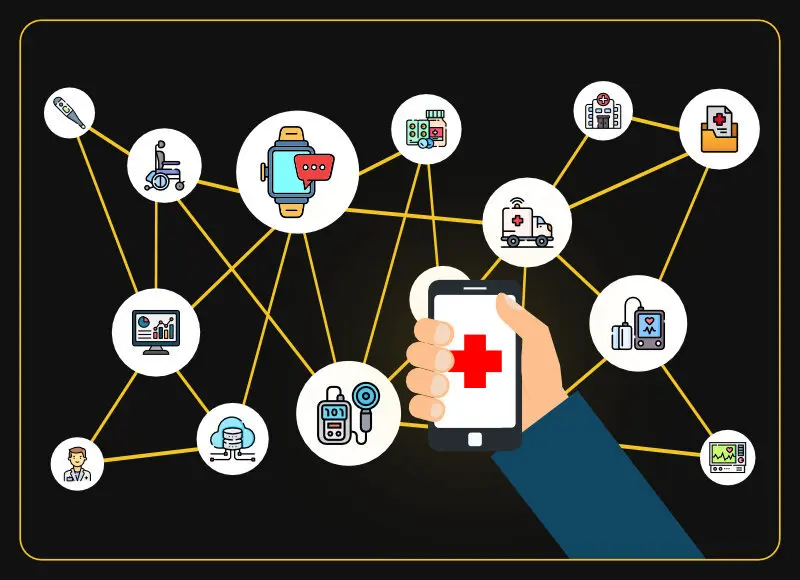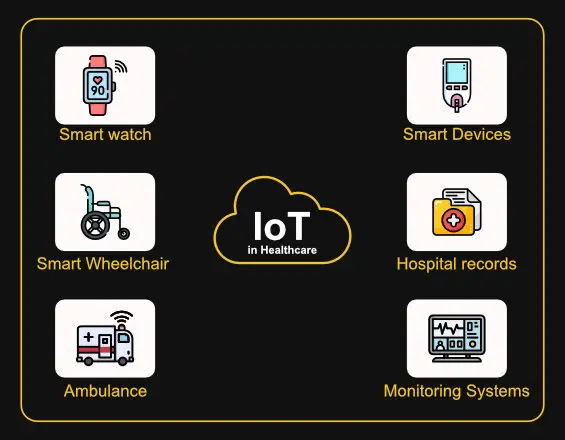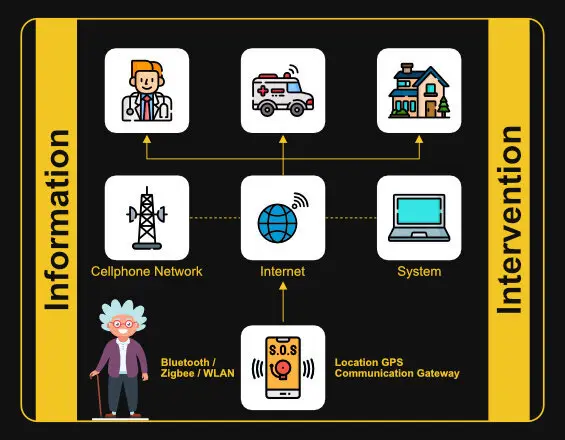
How a Footfall Counter System Transformed a Mall Digitally?
An accurate footfall counting system to offer actionable data for smarter business decision making
PsiBorg is not limited to developing Industrial IoT or consumer IoT solutions. We serve all sectors, including healthcare, where we cover all ranges of patient care, including hospitals and pharmacies. PsiBorg integrates IoT in healthcare by deploying smart sensors, end-to-end medical devices, and remote patient monitoring systems. Click the tab below to learn how your healthcare business can benefit from our IoT based healthcare product development services.

IoT in healthcare is bringing about a transformation in the healthcare industry through unique devices and people interaction which is delivering seamless healthcare solutions. IoT has applications in healthcare that benefit patients, families, physicians, hospitals, and insurance companies.
Wearable IoT devices such as fitness bands and other wirelessly connected devices like blood pressure and heart rate monitoring cuffs, glucometer etc. give patients access to personalized attention. IoT has brought about a positive change in people’s lives. This is especially true for elderly patients for whom constant health tracking has become a possibility. This is a boon for people living alone and their families These devices can serve reminders/alerts


IoT has enabled doctors and physicians to track their patients’ health conditions and its historical data more closely. They can track patients’ adherence to treatment plans or any need for immediate medical attention. IoT in healthcare enables professionals to be more watchful and connect with the patients proactively. Data collected from IoT devices can help physicians identify the best treatment process for patients and reach the expected outcomes.
Since it’s all technologically driven, it brings down the cost by cutting down unnecessary doctor’s visits, putting resources to better use and improvement in planning. IoT is here to change how the facilities are delivered to the healthcare sector, causing larger effects by bringing smaller changes.
With a four-step architecture, IoT is fairy simple to implement in a hospital setting. All the four steps are sequentially connected such that the data collected or processed at one stage and sends the value to the next stage.
Stage 1: Deployment of interconnected devices for collecting/gathering relevant data from Node Devices. These devices include sensors, actuators, monitors, detectors and camera systems etc.
Stage 2: Aggregation and Processing of analog data received from various sensors and devices.
Stage 3: Standardization of data and its dispatch to the the cloud platforms.
Stage 4: Advanced Analytics on cloud data for deriving useful actionable insights for driving better decision-making.
IoT in Healthcare has a bright future. With the advent of IoT, the access to healthcare and Emergency alert devices has been improved. At the same time quality standards in healthcare delivery have also gone up. As cellular IoT improves through better connectivity speeds with 5g network IoT in healthcare is bound to take rapid strides forward

1
Planning
PsiBorg starts any IoT development phase with planning. Firstly, the team experts strategically outline the scope and objectives of the solution and accordingly decide on resource allocation. The planning phase is the foundation of successful IoT solution development.
2
Analysis
After planning comes the requirement analysis stage, where the main objective is understanding the end user's needs and requirements. Our tech team gathers detailed insights to decide the flow of the development.
3
Design
In the design phase, a detailed blueprint of the project is created to clearly define the system’s architecture, data structure, and interfaces. In IoT solution development, the designing phase is also accompanied by prototyping, to validate the expected outcomes.
4
Implementation
In the implementation stage, the actual concept and product prototyping take place. The PsiBorg team, at this stage, initiates the MVP for the IoT solution. The implementation stage includes the development of all the hardware, firmware, and software. After implementation, the system undergoes integration and testing.
5
Testing & Integration
The testing stage is part of the development process because testing of the final product is necessary. Our team checks and thoroughly tests everything- hardware, firmware, and software. After conducting unit testing and validating the system, we deploy the project for production.
6
Maintenance
The final stage involves maintenance and support of the deployed solution. In the maintenance phase, PsiBorg offers to address waves, do updates, and provide ongoing assistance to the users.
Ready to elevate your IoT devices with advanced IoT solutions? Contact us today to discuss your project requirements and explore the possibilities.

Expertise
Our team comprises seasoned developers with a proven track record in delivering successful IoT projects.

Innovation
Stay at the forefront of technology with innovative IoT solutions tailored to your unique requirements.

Reliability
Trust in the reliability of our IoT products, ensuring the stable and secure operation of your IoT devices.

The true success of a business lies in the trust and partnership cultivated between clients and the company. Click to read about some of our proudest achievements.

How a Footfall Counter System Transformed a Mall Digitally?
An accurate footfall counting system to offer actionable data for smarter business decision making
STEP 1
Contact Us
Reach out to us via the contact form or give us a call to initiate the conversation about your IoT development needs.
STEP 2
Get Consultation
Schedule a consultation with our experts to discuss your project in detail, aligning our approach with your unique vision.
STEP 3
Get a Cost Estimate
Receive a detailed cost estimate tailored to your project’s scope and requirements, ensuring transparency in your investment.
STEP 4
Project Kickoff
Once finalized, we'll initiate the project kickoff, marking the beginning of our collaborative journey toward successful IoT product development.
In terms of healthcare, the Internet of Things (IoT) could be defined as the interplay between bedside monitors, smartwatches and fitness trackers, implanted medical devices, and any other object that transmits or receives a signal containing data that must be accessed or stored somewhere else.
IoT is helpful in improving the efficiency and outcome of healthcare. With the help of Medical IoT devices live data collection on health can be done on an ongoing basis. Due to this healthcare providers are able to make more informed health diagnoses, based on multiple indicators, and consequently better treatment decisions. Further, live streaming of data is capable of things like online surgery besides consultation.
Following are the five examples of IoT in healthcare:
With the help of IoT-enabled devices for patient monitoring, doctors have access to all necessary health data concerning a patient’s health history as well as data from remote monitoring of a patient’s vital signs such as blood pressure, pulse rate, heart rate etc. Thanks to telemedicine, people living in far off areas do not need to come to the hospital physically to attend treatment and can receive it remotely.